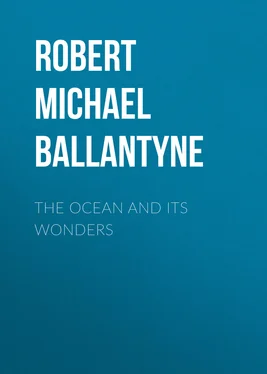Robert Michael Ballantyne - The Ocean and its Wonders
Здесь есть возможность читать онлайн «Robert Michael Ballantyne - The Ocean and its Wonders» — ознакомительный отрывок электронной книги совершенно бесплатно, а после прочтения отрывка купить полную версию. В некоторых случаях можно слушать аудио, скачать через торрент в формате fb2 и присутствует краткое содержание. Жанр: Детские приключения, literature_19, foreign_antique, foreign_prose, foreign_children, на английском языке. Описание произведения, (предисловие) а так же отзывы посетителей доступны на портале библиотеки ЛибКат.
- Название:The Ocean and its Wonders
- Автор:
- Жанр:
- Год:неизвестен
- ISBN:нет данных
- Рейтинг книги:4 / 5. Голосов: 1
-
Избранное:Добавить в избранное
- Отзывы:
-
Ваша оценка:
- 80
- 1
- 2
- 3
- 4
- 5
The Ocean and its Wonders: краткое содержание, описание и аннотация
Предлагаем к чтению аннотацию, описание, краткое содержание или предисловие (зависит от того, что написал сам автор книги «The Ocean and its Wonders»). Если вы не нашли необходимую информацию о книге — напишите в комментариях, мы постараемся отыскать её.
The Ocean and its Wonders — читать онлайн ознакомительный отрывок
Ниже представлен текст книги, разбитый по страницам. Система сохранения места последней прочитанной страницы, позволяет с удобством читать онлайн бесплатно книгу «The Ocean and its Wonders», без необходимости каждый раз заново искать на чём Вы остановились. Поставьте закладку, и сможете в любой момент перейти на страницу, на которой закончили чтение.
Интервал:
Закладка:
“Storm-waves,” as those unusually gigantic billows are called, are said to be the result of the removal of atmospheric pressure in certain parts of the ocean over which a storm is raging. This removal of pressure allows the portion thus relieved to be forced up high above the ordinary sea-level by those other parts that are not so relieved.
The devastating effects of these storm-waves is still further illustrated by the total destruction of Coringa, on the Coromandel Coast, in 1789. During a hurricane, in December of that year, at the moment when a high tide was at its highest point, and the north-west wind was blowing with fury, accumulating the waters at the head of the bay, three monstrous waves came rolling in from the sea upon the devoted town, following each other at a short distance. The horror-stricken inhabitants had scarcely time to note the fact of their approach, when the first wave, sweeping everything in its passage, carried several feet of water into the town. The second swept still further in its destructive course, inundating all the low country. The third, rushing onward in irresistible fury, overwhelmed everything, submerging the town and twenty thousand of its inhabitants. Vessels at anchor at the mouth of the river were carried inland; and the sea on retiring left heaps of sand and mud, which rendered it a hopeless task either to search for the dead or for buried property.
We have spoken of waves “travelling” at such and such a rate, but they do not in reality travel at all. It is the undulation, or, so to speak, the motion of a wave, that travels; in the same manner that a wave passes from one end of a carpet to the other end when it is shaken. The water remains stationary, excepting the spray and foam on the surface, and is only possessed of a rising and sinking motion. This undulatory motion, or impulse, is transmitted from each particle of water to its neighbouring particle, until it reaches the last drop of water on the shore. But when a wave reaches shallow water it has no longer room to sink to its proper depth; hence the water composing it acquires actual motion, and rushes to the land with more or less of the tremendous violence that has been already described.
Waves are caused by wind, which first ruffles the surface of the sea into ripples, and then, acting with ever-increasing power on the little surfaces thus raised, blows them up into waves, and finally into great billows. Sometimes, however, winds burst upon the calm ocean with such sudden violence that for a time the waves cannot lift their heads. The instant they do so, they are cast down and scattered in foam, and the ocean in a few minutes presents the appearance of a cauldron of boiling milk! Such squalls are extremely dangerous to mariners, and vessels exposed to them are often thrown on their beam-ends, even though all sail has been previously taken in. Generally speaking, however, the immediate effect of wind passing either lightly or furiously over the sea is to raise its surface into waves. But these waves, however large they may be, do not affect the waters of the ocean more than a few yards below its surface. The water below their influence is comparatively calm, being affected only by ocean currents.
The tides of the sea—as the two great flowings and ebbings of the water every twenty-four hours are called—are caused principally by the attractive influence of the moon, which, to a small extent, lifts the waters of the ocean towards it, as it passes over them, and thus causes a high wave. This wave, or current, when it swells up on the land, forms high tide. When the moon’s influence has completely passed away, it is low tide. The moon raises this wave wherever it passes; not only in the ocean directly under it, but, strange to say, it causes a similar wave on the opposite side of the globe. Thus there are two waves always following the moon, and hence the two high tides in the twenty-four hours. This second wave has been accounted for in the following way: The cohesion of particles of water is easily overcome. The moon, in passing over the sea, separates the particles by her attractive power, and draws the surface of the sea away from the solid globe. But the moon also attracts the earth itself, and draws it away from the water on its opposite side thus causing the high wave there, as represented in the diagram, figure 1 .
The sun has also a slight influence on the tides, but not to such an extent as the moon. When the two luminaries exert their combined influence in the same direction, they produce the phenomenon of a very high or spring-tide, as in figure 2 , where the tide at a and b has risen extremely high, while at c and d it has fallen correspondingly low. When they act in opposition to each other, as at the moon’s quarter, there occurs a very low or neap-tide. In figure 3 the moon has raised high tide at a and b , but the sun has counteracted its influence to some extent at c and d , thus producing neap-tides, which neither rise so high nor fall so low as do other tides. Tides attain various elevations in different parts of the world, partly owing to local influences. In the Bristol Channel the tide rises to nearly sixty feet, while in the Mediterranean it is extremely small, owing to the landlocked nature of that sea preventing the tidal wave from having its full effect. Up some gulfs and estuaries the tides sweep with the violence of a torrent, and any one caught by them on the shore would be overtaken and drowned before he could gain the dry land. In the open sea they rise and fall to an elevation of little more than three or four feet.
The value of the tides is unspeakable. They sweep from our shores pollution of every kind, purify our rivers and estuaries, and are productive of freshness and health all round the world.
The gentlemen here referred to are agreed as to the fact of systematic arrangement of currents, though they differ in regard to some of the causes thereof and other matters.
Chapter Four
Of the varied motions of the sea, the most important, perhaps, as well as the most wonderful, is the Gulf Stream. This mighty current has been likened by Maury to a “river in the ocean. In the severest droughts it never fails, and in the mightiest floods it never overflows. Its banks and its bottom are of cold water, while its current is of warm. It takes its rise in the Gulf of Mexico (hence its name), and empties into the arctic seas. Its current is more rapid than the Mississippi or the Amazon, and its volume more than a thousand times greater.”
This great current is of the most beautiful indigo-blue colour as far out as the Carolina coasts; and its waters are so distinctly separated from those of the sea, that the line of demarcation may be traced by the eye. Its influences on the currents of the sea, and on the climates and the navigation of the world, are so great and important, that we think a somewhat particular account of it cannot fail to interest the reader.
The waters of the Gulf Stream are salter than those of the sea; which fact accounts for its deeper blue colour, it being well known that salt has the effect of intensifying the blue of deep water.
The cause of the Gulf Stream has long been a subject of conjecture and dispute among philosophers. Some have maintained that the Mississippi river caused it; but this theory is upset by the fact that the stream is salt—salter even than the sea—while the river is fresh. Besides, the volume of water emptied into the Gulf of Mexico by that river is not equal to the three thousandth part of that which issues from it in the form of the Gulf Stream.
Читать дальшеИнтервал:
Закладка:
Похожие книги на «The Ocean and its Wonders»
Представляем Вашему вниманию похожие книги на «The Ocean and its Wonders» списком для выбора. Мы отобрали схожую по названию и смыслу литературу в надежде предоставить читателям больше вариантов отыскать новые, интересные, ещё непрочитанные произведения.
Обсуждение, отзывы о книге «The Ocean and its Wonders» и просто собственные мнения читателей. Оставьте ваши комментарии, напишите, что Вы думаете о произведении, его смысле или главных героях. Укажите что конкретно понравилось, а что нет, и почему Вы так считаете.












